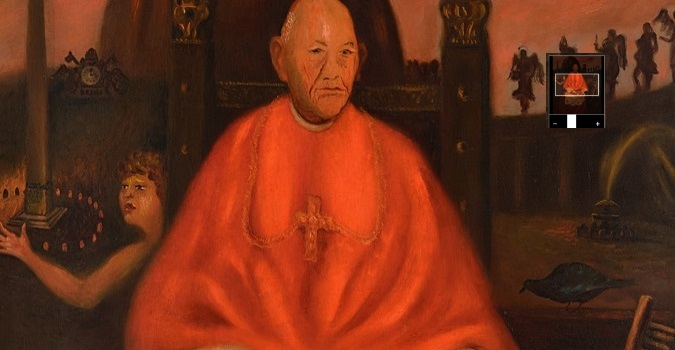Artwork of the month - September 2021
September 2021
Arturo Noci (Roma 1874 - New York 1953)
L'arancio, 1914, Oil on canvas, 113 x 97 cm
Inv. AM 364

The painting, purchased during the Second International Secession Exhibition in Roma in 1914, presents a young woman in an interior. She is sitting gracefully on the chair armrest covered in red, with an orange in her hand and two other fruits and a book on the armchair. Her clothing and hairstyle suggest that she is a young woman belonging to the progressive youth of the time; sensual in her intense expression and smiling in her gaze, she is preparing to taste the juicy fruit. The preliminary study Woman's Head (Rome, private collection) testifies to the careful meditation of the painting.
The whole surface of the painting - from the background wall adorned with a picture to the furniture, from the woman's clothing (a dark skirt and printed shirt in shades of yellow, orange and black) to the winking face framed by a fringe, in accordance with the fashion of the time - is characterised by a careful Divisionist technique. The minute pictorial texture is based on the contrast of the complementary colours red-green (the armchair and the back wall) and yellow-violet (the blouse and the skirt); dense, punctiform brushstrokes animate and enliven each individual field. Colour is therefore the protagonist right from the title, which, in accordance with a rather widespread fashion in Symbolist culture, ambivalently alludes to both the fruit and the dominant chromatic tone, orange.
Arturo Noci was an appreciated portrait painter of the Roman middle class. A specialist in the figure, he was one of those artists who lived at the turn of the century and stood between realism and symbolism, between academic training and modernism. The painting can be traced back to Noci's Secessionist and Divisionist period and demonstrates an absolutely mature use of this painting technique. The Secession, founded in Rome in 1912 and active with annual exhibitions from 1913 onwards, brought together those artists who, in dispute with the Società degli Amatori e Cultori di Belle Arti (Society of Lovers and Scholars of Fine Arts), which was considered conservative and lagging behind, sought new linguistic ideas in international culture and in the European secessions and who, in the Roman context, expressed this desire for renewal through the use of Divisionist technique. After its post-Impressionist beginnings, this technique came back into fashion in the 1910s, especially in the portraiture of the belle époque and, in the Roman context, was adopted by important artists such as Balla and Terzi, Innocenti and Lionne. Pointillism exalted the role of light and colour through a shattered and dynamic drafting achieved through the direct juxtaposition of bright and complementary colours, aimed at rendering, rather than the exactness of description, the luminous and chromatic complexity of the atmosphere, vibrant with variations.
At the height of his success and notoriety, in 1923 Noci moved to New York, where he continued his esteemed activity as a portrait painter of the ladies of the American and Italian-American upper middle class, of silent films and of the American show business.
Return to the section > The Galleria d'Arte Moderna artwork of the month







































